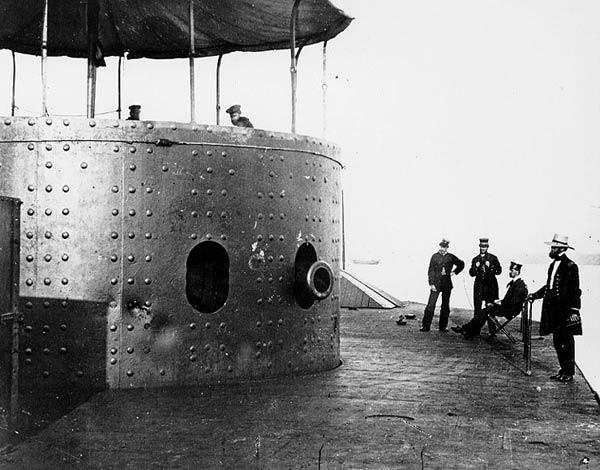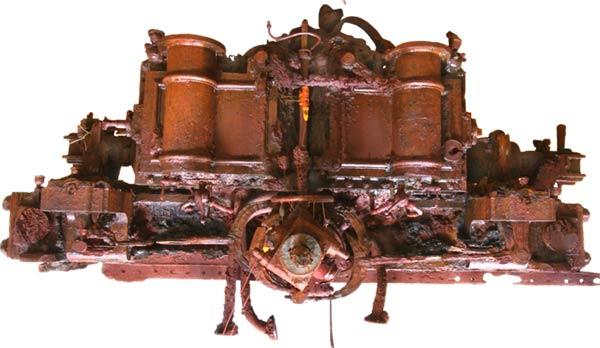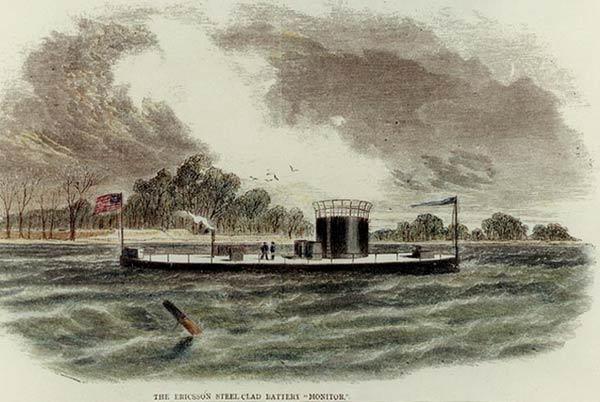Civil War Shipwreck's Iconic Engine Gets TLC


The order to abandon ship came just after midnight. The USS Monitor, a Union ironclad, was taking on too much water, caught in a violent storm. At approximately 1:30 a.m. on Dec. 31, 1862, the Monitor was overcome, engulfed by the crashing waves.
Almost 150 years later, conservators are getting the first up-close look at the sunken Monitor's 30-ton steam engine, an engineering wonder of its day, and the mighty heart of a ship that played a notable role in America's Civil War.
The USS Monitor went down in treacherous waters 16 miles (25 kilometers) off North Carolina's Cape Hatteras. The wreck was discovered in 1973, resting upside down on the ocean floor in about 235 feet (71 meters) of water. In a massive undertaking in 2001, the ship's engine was brought to the surface.
It was no ordinary steam engine. Designed by Swedish inventor John Ericsson, it was a "vibrating side-lever" engine with pistons that worked horizontally, an innovation that had allowed the compact, 400-horsepower engine to be entirely belowdecks, behind the Monitor's armor and impervious to enemy fire.
Freeing a giant
For almost a decade after it was recovered, the engine lay in a 35,000-gallon tank at the Mariners' Museum in Newport News, Va., soaking in purified, alkaline water, meant to loosen the barnacle-like sediment covering about 85 percent of the engine's surface.
"The water was clear, which almost made it more tantalizing. Because there it is just waiting," said David Krop, the conservation project manager for the museum's Monitor collection.
Get the world’s most fascinating discoveries delivered straight to your inbox.
A few weeks ago, the water was drained, and Krop and his crew, clad in dark-blue coveralls, finally got to take a crack at the engine, chipping away at a century and a half's worth of guck to the steady clang of hammer and chisels.
Krop said they had to be careful a wrong move could crack the corroded cast-iron components of the engine but that the work was intensely rewarding. "It's one of those addictive things, like a puzzle," Krop said.
"The neat thing is when you uncover a valve or a handle, because the copper alloy is extremely bright and shiny and it looks new," Krop told OurAmazingPlanet. "And just for that moment you realize, 'Wow, the engine must have been absolutely beautiful.'"
Game-changing ship
The engine was also supremely functional, and contributed to the Monitor's role in a symbolic turning point of the Civil War , according to Jeff Johnston, a historian at the Monitor National Marine Sanctuary.
Ericsson had designed and built the Monitor in just 108 days, after responding to a newspaper ad from the U.S. government calling for ironclad warship designs a desperate response to the Confederates' newly built ironclad warship, the Virginia.
On March 8, 1862, the Virginia destroyed two Union ships outside the harbor near Norfolk, Va.
But by the next day, there was a new ship in sight, the Monitor: the first all steam-powered warship ever built and the first to ever have a rotating gun turret.
The two ironclads did battle for four hours, the Monitor's two guns proving equal to the Virginia's 10 guns.
"Technically nobody won. It was a draw," Johnston said. "What won was armor: iron warships."
However, Johnston said, the Monitor's performance had a major impact on Union morale.
"At that point, the North really had no major victories in the Civil War a few skirmishes, but none of the big battles," Johnston told OurAmazingPlanet. "From the public perspective, the South was winning. It gave way to a very much needed victory in the minds of the northern press and public, whether it was true or not."
Back in the water
At the museum, Krop and his crew removed 4 tons of material from the Monitor's engine in two weeks. Now the engine is soaking again, this time in an electrically charged solution designed to remove yet more of the stubborn guck.
Krop said that eventually the steam engine will be entirely disassembled so that the parts can be properly conserved, and then put back together, a process that may not be completed until 2030.
In the meantime, the museum is hard at work preserving the hundreds of other artifacts that have been brought up from the wreck. Engraved silverware, a wool coat and furniture have been recovered.
In addition, two fully articulated skeletons were found in the Monitor's gun turret a sobering reminder that though 46 of the men on board were rescued on that stormy night in late 1862, there were 16 others who died.
Krop said these human stories are writ on the engine itself.
"It has very decorative handles on the valves, and brass wheels on the throttle," Krop said items turned by hand.
"All of them were left in the exact position they were in when the ship went down," Krop said, "so there are a lot of personal details tucked into that engine."
Reach Andrea Mustain at amustain@techmedianetwork.com. Follow her on Twitter @AndreaMustain.






